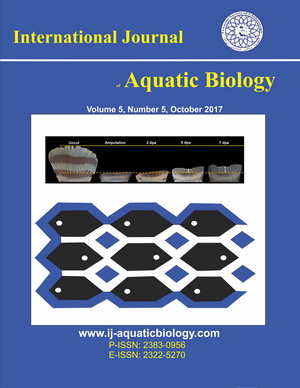Growth performance of common carp, Cyprinus carpio, fry at different experimental stocking densities in the environmental conditions of central Iraq
Downloads
This study aimed to examine the growth performance of common carp, Cyprinus carpio, fry in different stocking densities in the environmental conditions of central Iraq. The experiment was performed for 60 days at the central fish hatchery in the Suwayra district, the Kut Province. The study examined four groups: three with different stocking densities (1 million (T1), 1.5 million (T2), and 2 million (T3) fry per hectare) and a control group (T0) without supplementary feeding. The fry were reared in earthen ponds, with water quality parameters constantly monitored and maintained within optimal conditions. The results revealed that stocking density significantly impacted growth performance and survival rates. T2 exhibited the highest survival rate (84.91%) and the greatest final average weight (8.23 g). Furthermore, T2 displayed the highest specific growth rate (SGR) and daily weight gain (DWG), suggesting that this stocking density is optimal for the prevailing conditions in central Iraq. The economic analysis revealed that T2 had the highest profitability, with a benefit-cost ratio (BCR) of 1.2, followed by T1 (BCR = 1.18) and T3 (BCR = 1.00). Feed expenses accounted for the majority of total costs, emphasizing the importance of efficient feed management. The findings underscore the importance of maintaining optimal stocking densities and implementing effective feeding strategies to enhance growth performance and economic sustainability in common carp farming in Iraq.
Downloads
Abe H.A., Dias J.A.R., Sousa N.D.C., Couto M.V.S., Reis R.G.A., Paixão P.E.G., Fujimoto R.Y. (2019). Growth of Amazon ornamental fish Nannostomus beckfordi larvae (Steindachner, 1876) submitted to different stocking densities and feeding management in captivity conditions. Aquaculture Research, 50 (8): 2276-80.
Ali A.M., Jawad L.A. (2012). Larval development of the cyprinid fish Barbus sharpeyi (Gunther, 1874). Journal of Fisheries and Aquatic Science, 7(5): 307-319.
Anonymous (2022). Yearly fishery statistics of the Ministry of Agriculture in Iraq, the General Directorate of Animal Resources, Fish Resources Directorate.
Ahmed I. (2007). Effect of ration size on growth, body composition, and energy and protein maintenance requirement of fingerling Indian major carp, Labeo rohita (Hamilton). Fish Physiology and Biochemistry, 33(3): 203-212.
Ahmad M., Qureshi T.A., Singh A.B., Manohar S., Borana K., Chalko S.R. (2012). Effect of dietary protein, lipid and carbohydrate contents on the growth, feed efficiency and carcass composition of Cyprinus carpio communis fingerlings. International Journal of Fishery and Aquaculture, 4: 30-40.
Battese G.E., Coelli T.J. (1995). A model for technical inefficiency effects in a stochastic frontier production function for panel data. Empirical Economics, 20: 325-332.
Billard R. (1995). Carp: Biology and Culture. Published by Springer in association with Praxis-Paris. 342 p.
Boyd C.E. (1982). Water quality management of pond fish culture. Elsevier, Amsterdam. 318 p.
Boyd C.E., Tucker C.S. (2014). Handbook for Aquaculture Water Quality. Auburn: Craftmaster Printers, Inc., Alabama. 439 p.
Chakraborty B.K., Mirza M.J.A. (2007). Effect of stocking density on survival and growth of endangered bata, Labeo bata (Hamilton–Buchanan) in nursery ponds. Aquaculture, 265: 156-162.
Dabrowski K. (1984). The feeding of fish larvae: present “state of the art” and perspectives (*). Reproduction Nutrition Development, 24(6): 807-833.
Dabrowski K., (1982). Problems of fish nutrition in aquaculture. Postepow Nauk Rolniczych, 4: 151-167.
De las Heras V., Martos-Sitcha J.A., Yúfera M., Mancera J.M., Martínez-Rodríguez G. (2015). Influence of stocking density on growth, metabolism and stress of thick-lipped grey mullet (Chelon labrosus) juveniles. Aquaculture 448: 29-37.
Desai A.S., Singh R.K. (2009). The effects of water temperature and ration size on growth and body composition of fry of common carp, Cyprinus carpio. Journal of Thermal Biology, 34: 276-280.
Diemer O., Neu D.H., Sary C., Finkler J.K., Boscolo W.R., Feiden A. (2012). Artemia sp. Na alimentação de larvas de jundiá (Rhamdia quelen). Ciência Animal Brasileira, 13(2): 175-179.
Drew M.D., Ogunkoya A.E., Janz D.M., Van Kessel A.G. (2007). Dietary influence of replacing fish meal and oil with canola protein concentrate and vegetable oils on growth performance, fatty acid composition and organochlorine residues in rainbow trout (Oncorhynchus mykiss). Aquaculture, 267: 260-268.
Enache I., Cristea V., Ionescu T., Ion S. (2011). The influence of stocking density on the growth of common carp, Cyprinus carpio, in a recirculating aquaculture system, AACL Bioflux, 4(2): 146-153.
FAO (2022). The state of world fisheries and aquaculture 2022. Towards Blue Transformation. Rome, FAO.
Furné M., García-Gallego M., Hidalgo M.C., Morales A.E., Domezain A., Domezain J., Sanz A. (2008). Effect of starvation and refeeding on digestive enzyme in sturgeon (Acipenser naccarii) and trout (Oncorhynchus mykiss). Comparative Biochemistry and Physiology, 149(4): 420-425.
Garg S.K., Bhatnagar A. (1999). Effect of different doses of organic fertilizer (cow dung) on pond productivity and fish biomass in still water ponds. Journal of Applied Ichthyology, 15: 10-18.
Gawlicka A., Parent B., Horn M.H., Ross N., Opstad I., Torrissen O.J. (2000). Activity of digestive enzymes in yolk-sac larvae of Atlantic halibut (Hippoglossus hippoglossus): indication of readiness for first feeding. Aquaculture, 184: 303-314.
Gisbert E., Giménez G., Fernández I., Kotzamanis Y., Estévez A. (2009). Development of digestive enzymes in common dentex Dentex dentex during early ontogeny. Aquaculture, 287: 381-387.
Hamad H.A., Bawazir A.S., Ali A.M. (2016). Embryonic and larval development of (Gattan) Barbus xanthopterus (Heckel) from Tigris River system, Iraq. International Journal of Fisheries and Aquatic Studies, 4(6): 474-482
Khandan Barani H., Dahmardeh H., Miri M., Rigi M. (2019). The effects of feeding rates on growth performance, feed conversion efficiency and body composition of juvenile snow trout, Schizothorax zarudnyi. Iranian Journal of Fisheries Sciences, 18(3): 507-516.
Kodama G., Annunciacao W.F., Sanches E.G., Gomes C.H.A.M., Tsuzuki M.Y. (2011). Viabilidade econômica do cultivo do peixe palhaço, Amphiprion ocellaris, em sistema de recirculação. Boletim do Instituto de Pesca, 37(1): 61-72.
Maulu S., Hasimuna O.J., Haambiya L.H., Monde C., Musuka C.G., Makorwa T.H., Munganga B.P., Phiri K.J., Nsekanabo J.D. (2021). Climate change effects on aquaculture production: sustainability implications, mitigation, and adaptations. Frontiers in Sustainable Food Systems, 5:609097: 1-16.
Motta J.H.S., Vidal Jr. M.V., Glória L.S., Cruz Neto M.A., Silveira L.S., Andrade D.R. (2019). Technical and economic feasibility of food strategies in the hatchery of Cyprinus carpio (Cypriniformes, Cyprinidae) in a recirculating aquaculture system. Latin American Journal of Aquatic Research, 47(4): 626-637.
Oprea L., Mocanu M.C., Vanghelie T., Sandu P.G., Dediu L. (2015). The influence of stocking density on growth performance, feed intake and production of common carp, Cyprinus carpio L., at one summer of age, in ponds aquaculture systems. AACL Bioflux, 8(5): 632-639.
Pedreir M.M., Santos J.C.E., Sampaio E.V., Pereira N.P., Silva J.L. (2008). Efeito do tamanho da presa e do acréscimo de ração na larvicultura de pacamã. Revista Brasileira de Zootecnia, 37(7): 1144-1150.
Portella M.C., Dabrowski K. (2008). Diets, physiology, biochemistry and digestive tract development of freshwater fish larvae. In: J.E.C. Cyrino, D. Bureau, B.G. Kapoor (Eds..). Feeding and digestive functions of fishes. Enfield: Science Publishers. pp: 227-279.
Pradeepkiran J.A. (2019). Aquaculture role in global food security with nutritional value: A review. Translational Animal Science, 3(2): 903-910.
Rahman M.M., Verdegem M.C.J., Nagelkerke L.A.J., Wahab M.A., Milstein A., Verreth J.A.J. (2006). Growth, production and food preference of rohu Labeo rohita (H.) in monoculture and polyculture with common carp, Cyprinus carpio (L.), under fed and non-fed ponds. Aquaculture, 257: 359-372.
Rønnestad I., Yúfera M., Ueberschär B., Ribeiro L., Sæle Ø., Boglione C. (2013) Feeding behaviour and digestion physiology in larval fish: current knowledge, and gaps and bottlenecks in research. Reviews in Aquaculture, 5(Suppl. 1): S59-S98.
Ruane N.M., Carballo E.C., Komen J. (2002). Increased stocking density influences the acute physiological stress response of comm on carp Cyprinus carpio (L.). Aquaculture Research, 33(10): 777-784.
Sanches E.G., Tosta G.A.M., Souza-Filho J.J. (2013). Viabilidade econômica da produção de formas jovens de bijupirá (Rachycentron canadum). Boletim do Instituto de Pesca, 39(1): 15-26.
Schütz J.H. (2003). Avaliacao de diferentes tipos de alimentos e fotoper?´odos no crescimento e sobreviveˆncia de pos-larvas de dourado, Salminus brasiliensis (Pisces, Characidae). Master’s thesis.
Yang D.G., Zhu Y.J., Luo Y.P., Zhao J.H., Chen J.W. (2011). Effect of stocking density on growth performance of juvenile Amur sturgeon (Acipenser schrenckii). Journal of Applied Ichthyology, 27(2): 541- 544.
Yúfera M. (2018). Emerging issues in fish larvae research. Springer. 302 p.
Vadstein O., Attramadal K.J.K., Bakke I., Olsen Y. (2018). K-Selection as microbial community management strategy: a method for improved viability of larvae in aquaculture. Frontiers in Microbiology, 9: 2730.
Valenti W.C., Kimpara J.M., Preto B.L., Moraes-Valenti P. (2018). Indicators of sustainability to assess aquaculture systems. Ecological indicators, 88: 402-413.
Vega-Orellana O.M., Fracalossi D.B., Sugai J.K. (2006). Dourado (Salminus brasiliensis) larviculture: weaning and ontogenetic development of digestive proteinases. Aquaculture, 252(2-4): 484-493.
Zhen-Yu D., Yong-Jian L., Li-Xia T., Jian-Guo H., Jun-Ming C., Gui-Ying L. (2006). The influence of feeding rate on growth, feed efficiency and body composition of juvenile grass carp, Ctenopharyngodon idella. Aquaculture International, 14 (3): 247-257.
Copyright (c) 2024 International Journal of Aquatic Biology

This work is licensed under a Creative Commons Attribution 4.0 International License.








